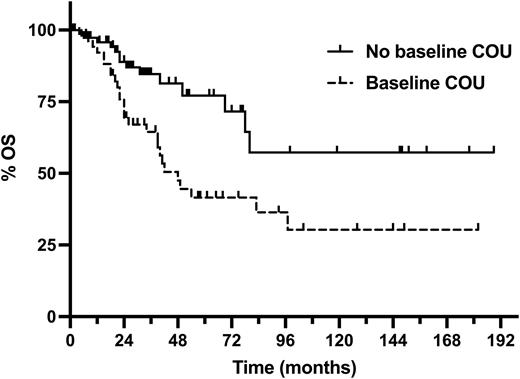Abstract
Overuse of opioid analgesics has been associated with a significant public health crisis, but at the same time, these medications are critical as an adjunctive treatment for bone pain in multiple myeloma (MM). Despite this, opioid use patterns in MM have not been well studied. Given the prolonged survival after autologous stem cell transplant (ASCT) and maintenance therapy, the effect of chronic opioid use (COU) on outcomes in these patients has become an important area to address. We aimed to describe COU in our ASCT cohort and its impact on long-term outcomes.
Adult patients ≥ 18 years (n=174) with MM who received ASCT between 2012 and 2019 at an urban medical center were included. COU was defined as having an active prescription for 3 consecutive months. Daily opioid doses were converted to morphine milligram milliequivalents (MME) using standard conversion factors (MME ≥ 20 mg/day has been correlated with risk for overdose events). A Poisson regression analysis including factors such as education level, alcohol, and illicit drug, use of non-opioid analgesics, and employment status, was performed to identify predictors of COU at baseline and 6 months after ASCT. Landmark OS and PFS analysis were performed at 6 months after ASCT to assess the impact of ongoing COU. A multivariate Cox proportional hazards ratio model adjusted for known prognostic factors was performed to identify predictors of OS.
The median age was 59 (29-78) years, 90 (51.7%) were male, 105 (60%) were Black, 24 (13.8%) were Hispanic, and 23 (13.2%) were White. At diagnosis, 111 (63.8%) patents were found to have IMWG-defined bone disease and 45 (25.9%) patients experienced a myeloma-related fracture.
At baseline (time of ASCT), COU was observed in 92 (52.9%) patients, 27 (29.3%) of whom did not have prior history of bone disease. The baseline average MME/day in the entire cohort was 65.3 mg (±70.0). Both COU rates (52.4% vs. 54%, p=0.98) and average MME/day (69.5 versus 55.2 mg; p=0.37) were similar in those with and without bone disease. In Poisson regression analysis, previous illicit drug use was associated with a higher baseline COU (RR 4.07, 95% CI 1.53-10.82; p=0.005). The use of non-opioid analgesic drugs (RR .024, 95% CI 0.09-0.63, p=0.004), being retired (RR 0.49, 95% CI 0.29-0.83; p=0.008), or employed (RR 0.37, 95% CI 0.15-0.91; p=0.031) were associated with lower baseline COU. Presence of bony disease was not associated with baseline COU (RR 1.11, 95% CI 0.78-1.58; p=0.569).
In the entire cohort, 142 (81.6%) patients received opioids during ASCT admission, while 105 (60.3%) were discharged on opioids and 72 (41.4%) had COU at 6 months after ASCT. Documented reasons for being discharged on opioids were presence of musculoskeletal (n=38, 45.8%), generalized (n=16, 19.3%), neuropathic (n=12), residual mucositis-related (n=11, 14.5%), and headache-related (n=6, 7.2%) pain. In baseline non-opioid users, 30 (36.6%) patients became new opioid users on discharge, and of these 13 (15.9%) remained on opioids at 6 months. Opioid use at hospital discharge was associated with higher COU at 6 months (RR 4.21, 95% CI 1.46-12.11; p=0.008). Indicators of disease burden, including bony lesions, were not associated with 6 month COU. 6-month MME/day was found to be relatively high at an average of 47.51 (±75.96) mg.
Although PFS was not different, OS was significantly worse in patients with COU at 6 months (48 months versus undefined, p=0.004; Figure 1) and in a multivariate model, we found that COU at 6 months strongly predicted for worse overall survival (HR 6.71, 95% CI 1.73-26.09; p=0.006).
Here we describe patterns of COU among MM patients undergoing ASCT, and in particular in long term survivors. We demonstrate high rates of baseline COU not related to the presence of bone disease. We highlight a high rate of opiate use on discharge including a number of new users after ASCT, which result in ongoing COU at 6 months. We show the negative impact of COU at 6 months on OS but not PFS suggesting that opioid-related morbidity may play a role. Finally, we demonstrate that MME/day throughout disease course is relatively high. These data highlight the need to improve understanding and management of pain in MM. Non-opioid analgesic use correlated with lower risk of COU and may be appropriate in managing pain effectively and safely.
Disclosures
Hofmeister:Bristol Myers Squibb: Membership on an entity's Board of Directors or advisory committees, Research Funding; GlaxoSmithKline: Membership on an entity's Board of Directors or advisory committees; Genzyme: Membership on an entity's Board of Directors or advisory committees; Sanofi: Research Funding; Janssen: Membership on an entity's Board of Directors or advisory committees; BlueBird Bio: Honoraria. Quigley:Rigel: Other: Advisory Board; Agios: Speakers Bureau; Alnylam: Speakers Bureau; Servier: Speakers Bureau. Sborov:Bioline: Consultancy; Amgen: Consultancy; Sanofi: Consultancy; Janssen: Consultancy, Membership on an entity's Board of Directors or advisory committees; BMS: Consultancy; GSK: Consultancy, Membership on an entity's Board of Directors or advisory committees; Abbvie: Consultancy; Pfizer: Consultancy. Calip:Flatiron Health, Inc.: Current Employment; Roche: Current equity holder in publicly-traded company; Pfizer: Research Funding. Patel:Exelixis: Current Employment.
Author notes
Asterisk with author names denotes non-ASH members.


